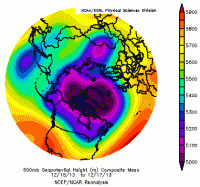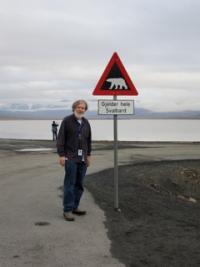What's going on with the Polar Vortex?
PMEL's Dr. Jim Overland explains how the warm Arctic relates to the extreme cold experienced by the U.S. in January 2014
What is the Polar Vortex?
Colder temperatures to the north and warmer temperatures to the south create winds that generally blow from west to east around the northern hemisphere. This atmospheric river of strong winds can vary from a straight west-to-east pattern, to a more wavy pattern. With the wavy pattern, cold air from the north can be carried south.
Is there a connection between the polar vortex that is occurring across parts of the country and climate change?
In the last five years, we’ve seen the jet stream take on more a wavy shape (left hand map below) instead of the more typical nice oval around the North Pole (right hand map below). This waviness is leading to colder weather down in the eastern U.S. and eastern Asia. Whether this is normal randomness or related to the significant climate changes occurring in the Arctic is not entirely clear, especially when considering individual events, but less sea ice and snow cover in the Arctic and relatively warmer Arctic air temperatures at the end of autumn suggest a more wavy pattern to the jet stream and more variability between the straight and wavy pattern.
This previous fall and the major cold event in early January show such variability. The connection between the Arctic warming trend and more severe weather in the mid-latitudes is an active area of research.
What is going on now?
The jet stream for January 6, 2014 (pale blue in left hand map) follows a wavy pattern over the whole Northern Hemisphere, and the path of the jet stream is out of the north over the central U.S., bringing cold air southward from the Arctic and producing record cold temperatures for the eastern half of the U.S..
More information...
- New! Polar vortex brings cold here and there, but not everywhere
- Wobbly polar vortex triggers extreme cold air outbreak (posted Jan 8, 2014 on Climate.gov)
- Arctic Mid-latitude Linkages: A bibliography
- Washington Post (2014, December 31) Sudden stratospheric warming: could it lead to a very cold January in D.C.?
- Arctic Oscillation index - current conditions & outlooks
- NOAA Arctic Theme Page
References:
- Overland, J.E., M. Wang, J.E. Walsch, J.C. Stroeve (2013): Future Arctic Climate Changes: Adaptation and Mitigation Timescales. Earth's Future, doi:10.1002/2013EF000162, in press.
- Francis, J. A. and S. J. Vavrus, 2012: Evidence Linking Arctic Amplification to Extreme Weather in Mid-Latitudes, Geophys. Res. Lett., Vol. 39, L06801, doi:10.1029/2012GL051000
- Overland, J.E., K.R. Wood, and M. Wang (2011): Warm Arctic–cold continents: Impacts of the newly open Arctic Sea. Polar Res., 30, 15787, doi: 10.3402/polar.v30i0.15787.





